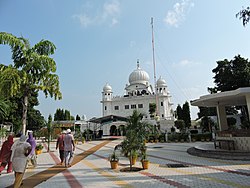

Kotla Nihang Khan
| |
|---|---|
| Kotla Nihang | |

Gurudwara Bhatha Sahib
| |
|
Location in Punjab, India Show map of PunjabKotla Nihang Khan (India) Show map of India | |
| Coordinates: 30°57′11″N 76°32′15″E / 30.95306°N 76.53750°E / 30.95306; 76.53750 | |
| Country | India |
| City | Ropar |
| State | Punjab |
| District | Rupnagar |
| Languages | |
| • Official | Punjabi |
| Time zone | UTC+5:30 (IST) |
| Website | rupnagar |

Kotla Nihang Khan is a suburb town of Ropar city in Punjab, India. It is famed as the erstwhile principality of the seventeenth-century Pathan zamindar ruler, Nihang Khan, who was an associate of the tenth Sikh Guru, Guru Gobind Singh.[1]
Kotla Nihang Khan is also a major archeological site associated with the Bronze Age Indus Valley civilization, dating to the 3300-1300 BCE period. Several underground structures, including a furnace dating to the Bronze Age, were unearthed here.[2] Kotla Nihang Khan's initial settlement has been dated to 2200 BCE based on analysis of excavated artifacts.[3] The excavated area here shows two distinct sectors: an eastern sector where pottery remains are indicative of Urban Harappan Culture, and a western sector where Urban Harappan artifacts are found mixed with Bara Ware. This is believed to indicate coexistence or a transition between the original Harappan inhabitants and the later Baran settlers at the settlement.[4]

This place is famous for a historical Gurdwara Bhatha Sahib. Guru Gobind Singh, the tenth Guru of the Sikhs, visited this place in 1688 during their return from Anandpur Sahib and stayed there where there was a brick kilan known as a Bhatha in vernacular Punjabi language. Later, the Gurdwara was built in memory of the visit of the Guru which came to be known as Bhatha Sahib.

There is a fort in the village known as Kotla Nihang Khan Fort which was built by the then Afghan Zimindar ruler Nihang Khan who ruled over 80 villages in the 17 Century.
... the Guru met Nihang Khan, the Zamindar of Kotla Nihang Khan, a place in proximity to present-day Ropar city. Nihang Khan was so moved that he decided to dedicate his all in the cause of the Guru. This happened on the Amavas or Maghar 1745 Bk 1688 ...
... similar to a furnace found at Kotla Nihang Khan, is located here. It is an overground oval structure built with the long axis of about 1 to 1.5 m ...
... The date of Kotla Nihang Khan is about 2200 bc (ii) Rupar and Other Sites The Nalagarh mound at Rupar on the Satluj was excavated by YD Sharma in 1953-56. In the lowest stratum, Harappan potteries, bronze implements ...
... The mound at Kotla Nihang Khan is divided into two sectors: eastern and western. The eastern sector mainly has Urban Harappan pottery like the dish-on-stand, goblets with pointed base, shallow flat dish with flaring sides ... The western part has Urban Harappan elements mixed with Bara Ware from the lower levels. Sharma (1982: 141) thinks that ... initially, in Phase I, the Harappans occupied the eastern area, but with the advent of the Barans ...
|
Cities and towns in Rupnagar district
| |
|---|---|
| Rupnagar |
|
| Other districts |
|
This article about a location in the Indian state of Punjab is a stub. You can help Wikipedia by expanding it. |
This Indian history-related article is a stub. You can help Wikipedia by expanding it. |